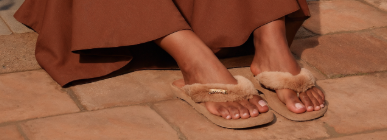

You will be notified when the product is available!
Enjoy your discount code:
Original from Brazil since 1962
Havaianas has been spreading the Brazilian spirit around the world since 1962, with their iconic rubber sole and bright, colourful, summer-infused designs.
With over 250 million pairs sold every year in more than 100 countries, Havaianas has become synonymous with modern flip-flops, cementing itself as a must-have for beachgoers and trendsetters alike. From the streets of Brazil to the halls of the most famous contemporary art museum in New York – a true global icon.

A star is born (1962)
Havaianas were created in Brazil in 1962 through inspiration from the Zori sandal; a traditional Japanese sandal with cloth straps and woven rice straw soles. Havaianas replaced the straw with rubber, updated the design to look modern, and the rest is history! This is why Havaianas' soles feature a rice grain pattern; one of the many design elements that make Havaianas so unique.
So where did the name “Havaianas” come from? Well, in Portuguese, the name translates to “Hawaiians” and it was chosen to honour the tropical and glamorous destination for the holidays with endless summer vibes.

The Kombi (1964)
By 1964, practically every Brazilian employee wore a pair of Havaianas. Travelling salesmen would sell Havaianas directly from their vintage Volkswagen Kombi vans throughout Brazil. The vans were always greeted with excitement wherever they appeared!

The original rubber (1966)
Not to brag, but Havaianas invented the original rubber flip-flop! Here’s our proof: In 1966, Havaianas’ parent company, Alpargatas, registered the patent for our now world famous rubber thong!

More colours (1969)
At first, Havaianas were only available in blue and white. But in 1969, a production error produced a batch of green Havaianas, which ended up hitting the marketplace. The reaction was so positive that Havaianas seized the opportunity and started to produce a wider variety of colours, including green, brown, yellow, and black.

An essential (1980)
Havaianas was officially recognized as an intrinsic part of Brazilian culture by the Brazilian Government after they were included on a list of core products (alongside rice and beans!) to control inflation. By this point, millions of pairs of Havaianas were being sold each year in Brazil.

Rainbow and prints (Mid 1990's)
Did you know that a trend started in the 90s when surfers flipped the white soles of their Havaianas upside down to create single colour flip-flops? After noticing this trend, Havaianas introduced single coloured styles and launched their first ever printed style featuring a hibiscus flower.
Many more printed designs continued to be released with new colourways and new product developments (such as baby designs!).

Brazilian passion (1998)
To celebrate the ’98 World Soccer Championship Havaianas launched “Havaianas Brazil” – a style with a small Brazilian flag on the strap. It still remains one of Havaianas' best-selling styles globally.

Runway icon (1999)
Havaianas transcends into the world of fashion after making a runway debut in French designer Jean Paul Gaultier’s runway show. Soon after, Havaianas began working with some of the biggest and best brands and designers from around the world.

Re-inventing the Classics (2000-Present)
Havaianas never ceases to innovate, and year after year, continues to release new styles such as the Slim, the Sandals and the Square. Besides that, the brand has also launched special collections with details like crystals and embroideries, handcrafted by Brazilian artisans.